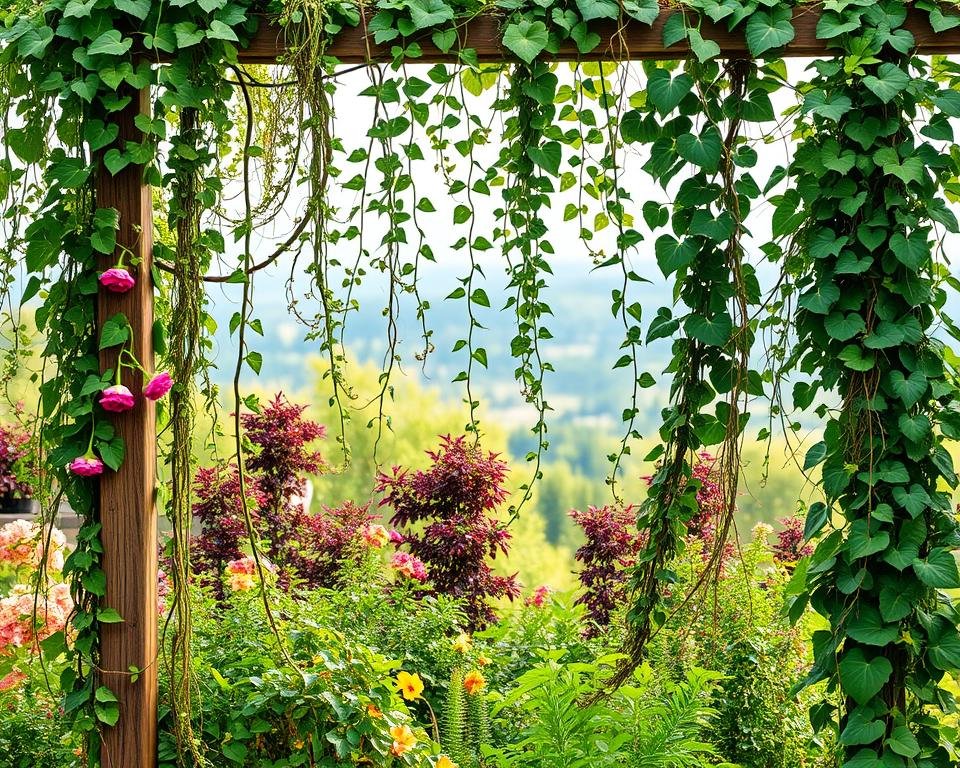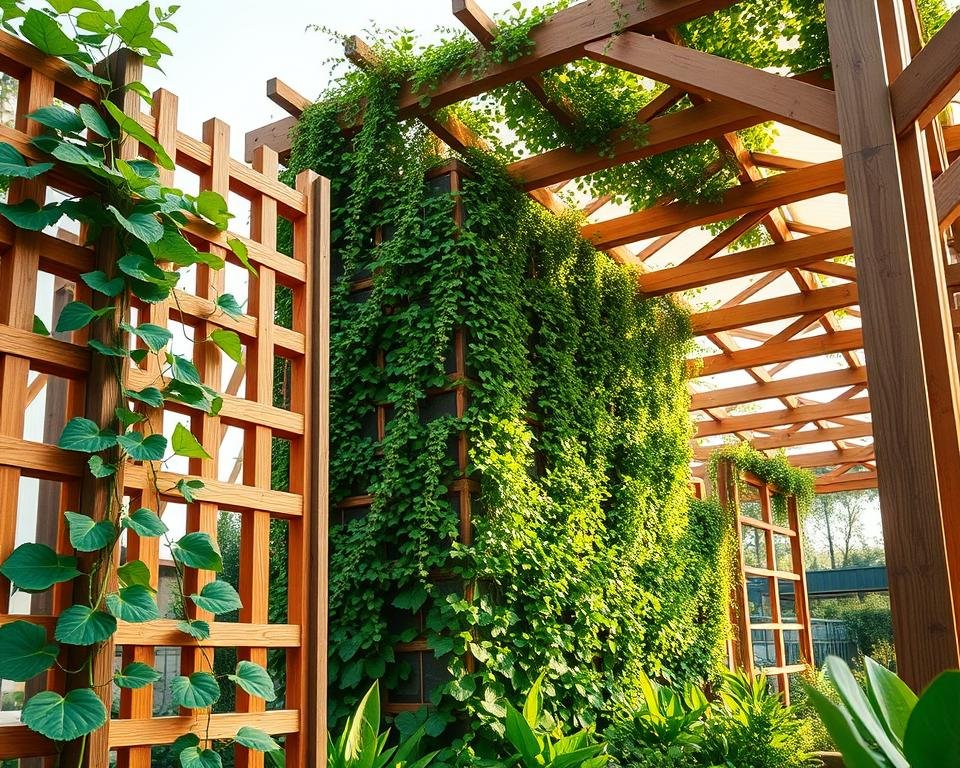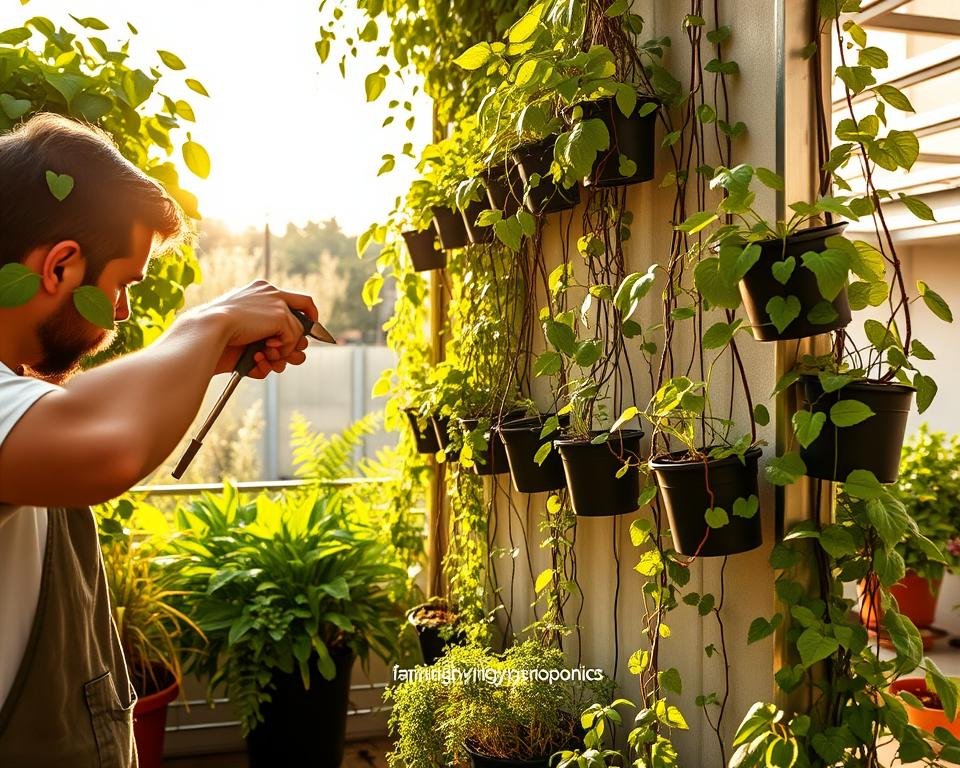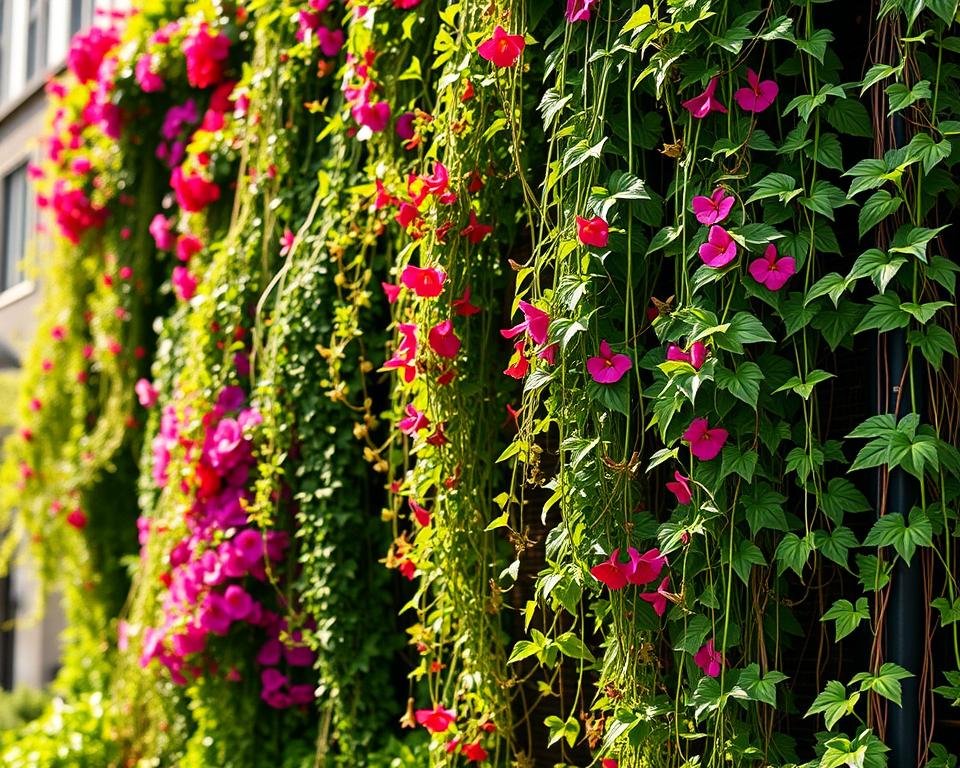Harnessing Climbing Plants for Vibrant Vertical Gardens
Standing on my small urban balcony, I saw how climbing plants can change a small space into a lush oasis. Vertical gardens are more than just a trend. They bring life to cities.
Climbing plants let you use your garden’s vertical space to the fullest. They turn blank walls and fences into green walls. Whether you have a small balcony or a big backyard, vertical-gardens are a fresh way to garden.
People in cities are finding out that climbing plants do more than look good. They clean the air, cool down the city, and help local plants thrive. Your vertical garden can be a beauty and a force for nature.
Key Takeaways
- Climbing plants maximize limited urban garden spaces
- Vertical-gardens improve air quality and reduce urban heat
- Natural support structures can transform architectural surfaces
- Vines offer aesthetic and environmental benefits
- Vertical-gardening supports urban biodiversity
Understanding the Art of Vertical Gardening with Climbers
Vertical-gardening turns ordinary spaces into lush green landscapes. It’s perfect for urban dwellers and garden lovers. Climbing plants help create stunning living walls, making the most of small spaces and adding beauty.
Climbing plants are versatile in green wall design. They can dramatically change your living spaces. They offer both beauty and practical benefits.
Types of Self-Clinging Plants and Support Systems
Vertical-gardening has two main types of climbers:
- Self-clinging plants with tendrils, suckers, or aerial roots
- Trailing plants needing trellis or wire support
Popular self-clinging plants include ivy and Virginia creeper. They stick to surfaces using special mechanisms.
Benefits of Growing Vertical-Gardens
Vertical-gardens bring many benefits to urban areas:
| Benefit | Impact |
|---|---|
| Space Maximization | Turns small areas into green sanctuaries |
| Air Purification | Removes up to 25% of indoor air pollutants |
| Energy Efficiency | Can cut energy costs by up to 30% |
“Vertical-gardens are not just design elements; they’re living, breathing ecosystems that enhance our urban spaces.” – Urban Gardening Expert
Planning Your Living Wall Project
When planning your vertical garden, keep these factors in mind:
- Sunlight exposure
- Wall structural integrity
- Irrigation requirements
- Plant selection
Recommended climbing varieties like wisteria, clematis, and ornamental climbers can create stunning green walls. With proper planning and care, your vertical-gardening journey starts here.
Climbing Plants: Selection and Classification

Finding the right climbing plants can turn your outdoor area into a stunning work of art. With over 300 species of climbing plants, you have many options. These vines can make your garden beautiful and useful.
Let’s look at some top climbing plants for your garden:
- Clematis: Known for its stunning flowers that can reach up to 8 inches in diameter
- Wisteria: Rapid grower perfect for pergolas and large structures
- Honeysuckle: Attracts hummingbirds with colorful blooms
- Climbing Roses: Fragrant and elegant vertical garden addition
When picking climbing plants, consider a few things:
- Growth rate
- Mature size
- Flowering period
- Environmental preferences
“Choose climbing plants that complement your specific garden conditions and design goals.”
Knowing how different vines grow is key to a great vertical garden. Whether you want fast-growing vines like Morning Glory or structured ones like Boston Ivy, you’ll find the perfect one. It will change your garden for the better.
Essential Support Structures and Training Methods
To make a stunning vertical garden, pick the right support structures. These should match your trellis plants and creepers. The right choice can turn any space into a beautiful living wall.

Exploring Trellis and Support Options
When you design your vertical garden, you’ll find many support systems. These include:
- Wooden lattices for a classic look
- Metal grid systems for modern vibes
- Wire supports for light creepers
- Pergolas and arches for a dramatic look
Professional Installation Techniques
For a successful vertical garden, proper installation is key. Consider these for espalier plants and climbers:
- Strong anchoring is a must
- Good drainage is crucial
- Choose the right planting medium
- Spread weight evenly
*”A well-designed support structure is the backbone of any successful vertical garden.”*
Maintaining Your Garden’s Structural Integrity
Keep your vertical garden healthy with regular care. Check supports often for damage, strengthen them as plants grow, and clean wooden ones to avoid rot.
Your vertical garden’s success depends on the right support, proper installation, and upkeep. With careful planning, you can make a stunning green wall that changes your space.
Best Practices for Planting and Maintenance
Creating a thriving vertical garden with climbing plants needs careful planning and consistent care. Whether you’re growing ornamental climbers or functional green walls, knowing the right techniques is key. It can turn your space into a lush, vibrant area.

First, pick the right climbing plants for your environment. Consider a few things:
- Check how much sunlight your plants need (60% of clematis do best in sunny spots)
- Make sure the soil drains well and has the right nutrients
- Think about how the plants will grow and if they need support
Soil preparation is key for a successful vertical garden. Add organic matter to help with drainage and keep nutrients. Self-clinging climbers like Boston ivy need little care but sometimes need support.
“The right support can turn a simple climbing plant into a living architectural piece.” – Garden Design Experts
Pruning methods differ for each plant. For example, wisteria needs special pruning for the best blooms. Climbing roses and honeysuckle, which can bloom in May, might need different training.
| Climbing Plant Type | Support Needs | Maintenance Level |
|---|---|---|
| Clematis | Trellises, wires | Moderate |
| Boston Ivy | Wall-mounted supports | Low |
| Climbing Roses | Sturdy frames, netting | High |
Keep an eye out for pests and diseases. Protect your garden with preventative care and fix problems fast. With hard work, your climbing plants will make a stunning, living green space. It will improve both indoor and outdoor areas.
Conclusion
Starting your vertical garden journey with vines opens up a world of creativity. Plants like passion fruit vines can grow up to 30 feet in a year. Climbing roses, such as ‘New Dawn’, add beauty and function to small spaces.
Vertical-gardens are more than a trend. They help improve urban environments by reducing cooling needs and creating habitats for wildlife. By using climbing plants, you can create shaded areas and even grow food.
Every vertical garden you create helps in conservation efforts. The goal is to protect 30% of land and sea by 2030. Your garden can help lock away carbon, support biodiversity, and look beautiful.
Keep trying new vines and support structures in your vertical garden. Remember, it needs careful planning, regular care, and a desire to learn. Your green wall can be a living, changing work of art that shows your creativity and commitment to the environment.







